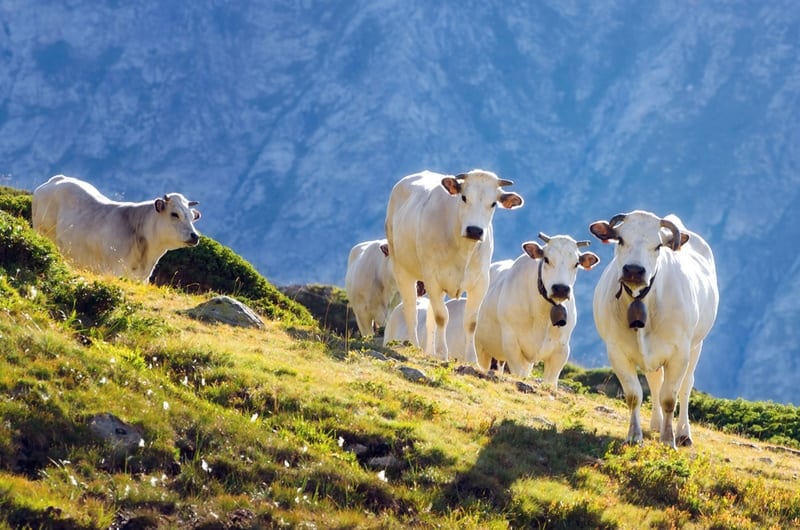Originally hailing from Italy, Piemontese cattle have spread throughout the world as a popular beef cattle for ranchers and farmers alike. They have a unique gene mutation that causes double muscle growth which results in a lean-to-fat ratio beef that tends to be lower in cholesterol. Read on to learn more about this popular cattle breed for beef and milk production.

Quick Facts About the Piemontese
| Breed Name: | Piemontese; Piedmontese, or razza bovina Piemontese |
| Place of Origin: | Italy |
| Uses: | Beef and dairy production, draught |
| Bull (Male) Size: | 1543 to 1874 pounds |
| Cow (Female) Size: | 1146 to 1213 pounds |
| Color: | White or wheaten with gray coloring |
| Lifespan: | 9 years |
| Climate Tolerance: | All climates |
| Care Level: | Easy |
| Production: | Beef and milk |
Piemontese Origins
The Piemontese cattle originated in Northwest Italy in the region of Piedmont. Della Langa, Canavese, the Ordinario di Pianura, the Demonte, and the Scelta di Pianura were all different types of Piemontese cattle that were local to Italy until the end of the nineteenth century. These cattle were typically used for three purposes: milk, beef, and draught power. At the end of the nineteenth century, selective breeding began to make Piemontese dual-purpose, primarily as sources of beef and milk production. Piemontese entered the US in the 1980s and became the foundation stock to breed the beef cattle called North American Piedmontese cattle.

Piemontese Characteristics
The unique characteristic that makes Piemontese cattle sought after is the genetic mutation of inactive myostatin genes. Myostatin is a protein that is secreted in the muscle tissue of mammals that helps control the development of muscle within the body. In Piemontese, the inactive myostatin genes cause hypertrophic muscle growth, or double muscling, which means the cattle have a higher lean-to-fat ratio resulting in beef with less fat and cholesterol.
Piemontese cattle are known for being docile and having a motherly temperament toward their offspring. The cows are fertile, providing good milk yield, and usually produce for nine years or longer. Milk from the Piemontese is typically used for cheese production in Italy.
Uses
Piemontese cattle are used primarily used for dual-purpose in the United States, as both beef and milk cattle. Historically the Piemontese was produced for three purposes: draught, beef, and milk production. When it was discovered that Piemontese carry a gene mutation that causes hypertrophic muscle growth, or double muscling, the cattle were bred to become dual-use for beef and milk rather than draught.

Appearance & Varieties
The Piemontese cattle of today are medium-sized with bulls weighing in around 1543 to 1874 pounds and cows coming in around 1146 to 1213 pounds. Calves are fawn-colored upon birth and become white-gray as they grow into adulthood. Piemontese cattle typically have black skin covered by a white or wheaten with gray coloring for their coat. Bulls and cows both have horns in this particular breed of cattle. The cows stand at roughly 52 inches in height while the bulls stand anywhere between 51 inches to 53 inches in height.
Population/Distribution/Habitat
Currently, there are roughly 28-30 million heads of cattle in the United States. Roughly 70% of cattle in the U.S. are Angus cattle with Piemontese making up roughly less than one-half of 1% of the cattle in the country. The North American Piedmontese Association (NAPA) is the official breed registry in the United States. They are a non-profit breed registry and require mandatory registration of Piemontese that are homozygous (2 copies) of the myostatin allele mutation that causes hypertrophic muscle growth.
Are Piemontese Good for Small-Scale Farming?
Piemontese are suitable for small-scale farming. The cows have a suitable milk yield for cheese production. Cows are also known to be fertile, which can lead to more milk production and the introduction of more bulls for beef production. The double-muscle of the Piemontese bulls makes them ideal for beef production with lean beef that is lower in fat and cholesterol than other commercial beef on the market.

Final Thoughts
Piemontese cattle are a great choice for milk and meat and can be used on small-scale farms and larger commercial operations.
Featured Image Credit: francesco de marco, Shutterstock
